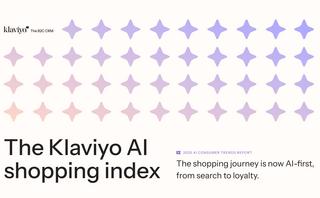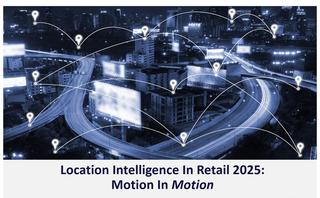Start your search by choosing one tag below or type your query in the search field above.
-

AI tools such as ChatGPT and Google Gemini are embedded into daily life, and now agentic models are driving the next wave of retail disruption by diving deep into consumer motivations and shopping patterns — even making purchasing decisions for them.
This shift to agentic commerce could potentially represent a $900 billion to $1 trillion opportunity in U.S. retail alone by 2030, according to McKinsey & Co.
-

Four out of five consumers have used AI for shopping or product research in the last three months. Find out what that means for your business with our latest report, featuring fresh insights and strategic recommendations.
Read your copy of the Klaviyo AI Shopping Index to discover:
How AI-native brands grow differently (and why they’ll win)
Why other AI platforms can’t keep up with Klaviyo
How AI supports marketers and drives more revenue
-

2025 has been a year of sweeping change — both technologically thanks to AI, and economically as President Trump’s tariffs reshape the landscape of global trade. Not surprisingly, all this change has also shifted consumers’ shopping behaviors, and new research from consulting firm BCG showcases exactly how that’s playing out this holiday season.
The findings underscore the driven, deal-seeking behavior that consumers are bringing to this holiday season, something that has already been widely seen this year, as early as Amazon’s July Prime Day event. But while holiday shopping has been creeping earlier into the year for some time now, what’s becoming clear this year is that consumers are so intent on finding the best deals and saving money that they are willing to wait to buy — in particular for major holiday sales events like Black Friday — and they are drawing on the impressive research and deductive powers of AI to help them find the right time and place.
-
You are currently enjoying the free trial mode which gives only back 3 results for each of your searches.
Free NewsletterOnly paid members can get full access to the most recent content, create their own tags & personal folders, assign search results to specific projects and much more… all of this for less than 99c a day.
-

How AI shopping impacts main street retail
For stores in downtown shopping districts and suburban strip malls, AI shopping could be an opportunity to play to a merchant’s strengths. Agentic commerce — the concept of AI agents shopping for humans — is a hot topic, in part because of commercial opportunity amid uncontrollable uncertainty.
Shopping Experience
“Agentic commerce is accelerating a bifurcation we’re already seeing,” said Andrew Stern, CEO and co-founder of Quilt Software, which makes operational tools for independent retailers.
-

Location intelligence
Each day, shoppers create enormous amounts of data about themselves, their habits, and their preferences. As a result, supply chains (if leveraged properly) can virtually “talk” to retailers, manufacturers, and shippers.
But none of that data becomes actionable if retailers and their partners can’t get that data to tell a meaningful story. This research aims to find out how well retailers – and their trading partners – are able to convert this data into insight.
-

Where points miss the point with customer loyalty and engagement
Why do buyers stick with certain brands? It’s simple: they find ongoing value at a price they are willing to pay. Yet, that’s not how many marketers are continuing to manage their loyalty programs. Instead, they’re stuck in a loop, banking on rewards points and mediocre discounts that customers often forget about. Loyalty programs today are missing the mark, becoming stale and ineffective due to a failure to grasp what truly drives loyalty: a consistently fulfilled brand promise within a unified customer experience that makes it easy to make a purchase or and targeted loyalty benefits that solve a problem.
-

Shopify says AI traffic is up 7x since January, AI-driven orders are up 11x
E-commerce software provider Shopify is bullish on AI-powered shopping agents, citing AI as an “incredible tool” to enable more entrepreneurs and calling it the “biggest shift in technology since the internet” during its third-quarter earnings call. The company, which partnered with ChatGPT maker OpenAI in September, reported that traffic from AI tools to its online stores is up 7x since January of this year, and purchases attributed to AI-powered search have increased by 11x.
-

Ulta aims for new shoppers and more spend with new marketplace
Marketplaces have become the go-to way for retailers to quickly expand their assortment in a low-risk way. And Ulta wants in. The cosmetics retail chain recently launched UB Marketplace not to expand the assortment of its core offering, but to test products in adjacent categories, such as grooming, wellness, pro tools and global beauty, said James Lang, Vice President of Marketplace at Ulta.
“We like to think of this as the second floor to our digital store,” Lang said. “These brands, these categories that we’re launching are really things that you would expect to see, and if we had more floor space, you would naturally see these brands in our stores.”
-

How to build customer trust and loyalty through personalization
What’s really critical for businesses to keep in mind is that it has never been truer that a customer’s best experience with any brand anywhere sets the bar for their next experience - including their next experience with you. So, how do we, regardless of industry, meet and exceed those expectations?
This article, inspired by insights shared during a recent webinar, explores that question by addressing three critical aspects of building customer trust and loyalty:
-

Top 5 retail tech trends shaping 2025
The most impactful retail tech developments this year aren’t flashy upgrades or abstract promises. They’re tools grounded in day-to-day problems: peak-hour chaos, employee safety, hidden losses, and inconsistent decision-making. Retail technology in 2025 is less about flash and more about function. The newest tools don’t just look smart but actually respond to real pressure points inside stores like inventory delays, staffing issues, fraud risks, and safety concerns.
-

Worldpay brings support for OpenAI’s Agentic Commerce Protocol
Payment technology provider Worldpay is now supporting OpenAI’s Agentic Commerce Protocol (ACP). As the company noted in a news release Wednesday (Oct. 29), this is an open standard for artificial intelligence (AI) commerce allowing AI agents, people and businesses to work together on purchases.
With ACP, the release added, U.S. users of OpenAI’s ChatGPT will be able to shop directly from participating Worldpay merchants using Instant Checkout.